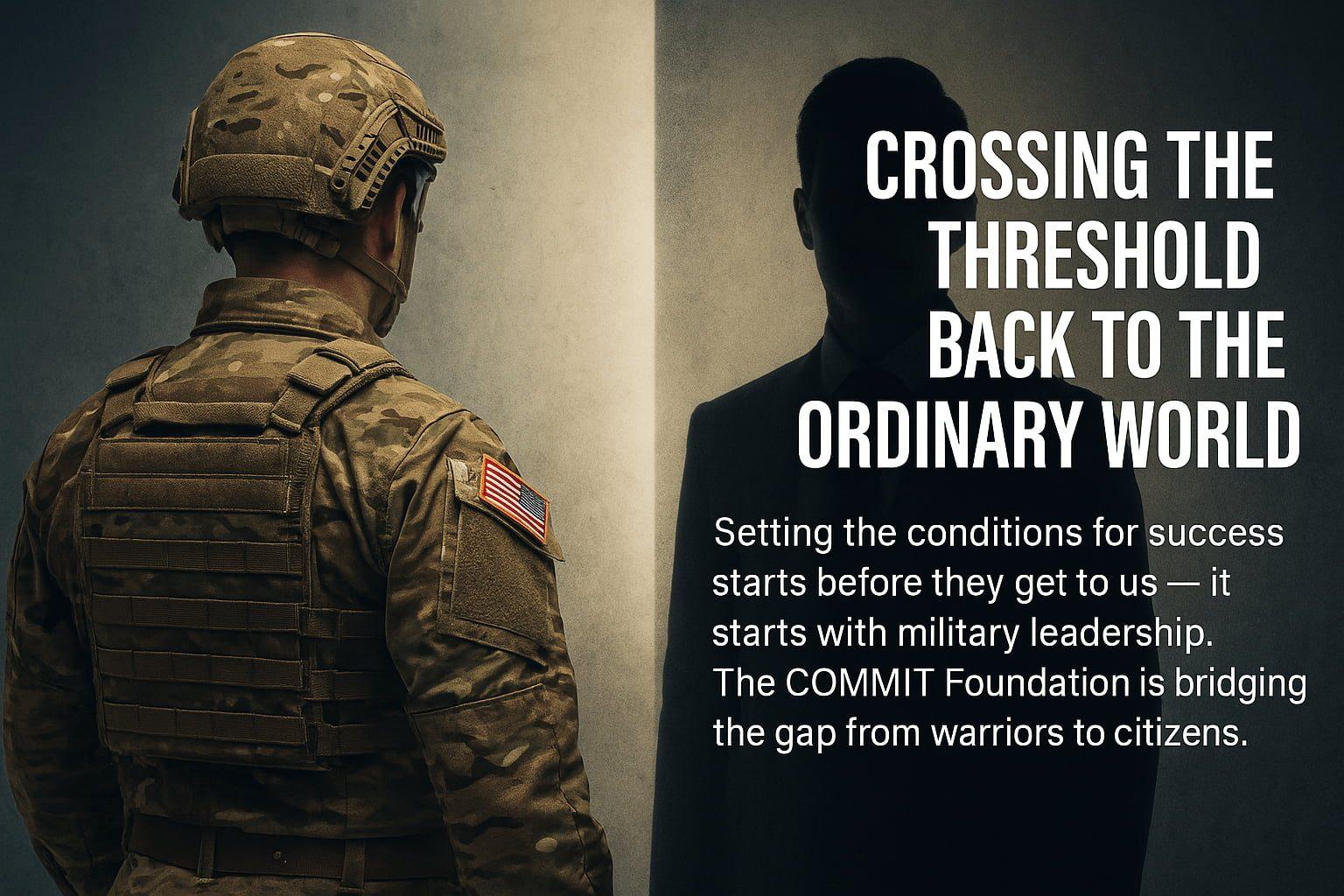
Apr 11, 2025
Crossing the Threshold Back to the Ordinary World
Shared by Jason Roncoroni:
What I always find interesting about this challenge is the lack of investment from the military to help people leave. I know. It sounds counterintuitive. Just hear me out. We have an involved process to prepare men and women for deployment. In the army we called this the Soldier Readiness Processing (SRP). Included are activities like life insurance (SGLI), powers of attorney, and wills. We even take a “death” photo - the picture that will memorialize your service should you not come home. We take such care and precaution in the event that you die, but what preparation occurs when you leave the other way? You know, out the front gate? Does the unit do your headshot? Do they have one-on-one counseling about your resume in the same way that you talk to an attorney about your life insurance payments and the location of your will? No. We don’t do any of this - even though we should.
For an institution that openly preaches empathy for the service member and compassion for the family, it should surprise you to learn that we do relatively nothing when it comes to the most difficult part of the entire military journey - leaving. Crossing that threshold back into society. I know we feel pressure to meet retention objectives, and we want good service members to stay. But here’s the thing: sooner or later, everyone leaves. Nobody gets to stay forever. From the youngest first term soldier to the Chairman of the Joint Chiefs of Staff, everyone either leaves by way of a memorial service or by driving out the front gate. How is it that we excel to support one and fail so miserably in the other?
The purpose of this article is to explore what you can do as an organizational leader or a transitioning service member to address this shortfall in how we bridge the gap between the military and civilian world. Now, I know you can’t simply walk away. That isn’t who you are. You can’t throw yourself into the job until the day you leave either. But that doesn’t help anyone. Not the unit. Not you. In order to address this challenge, let’s start by exploring the organizational perspective. More specifically, let's talk about how your supervisors and commanders shape your final 12 months in the military. Typically this can occur in one of three ways: banishment, punishment, or empowerment.
Banishment, Punishment, or Empowerment
Banishment refers to the leadership state of mind. The idea that you are treated differently because you made the choice to leave. It represents the mental, emotional, and psychological response to the idea of someone exiting the breach. Leaving the band of brothers. Some might even say you are quitting. Hell, you might even think that about yourself. This will typically present itself through passive aggressive behaviors that build until you reach a breaking point. Along the way, it erodes trust. It can destroy relationships. It could sour your reputation and your memory of the service. Both sides throw up their arms in anger because they aren’t getting what they need from the other. Insecure leaders will grieve the loss of your contribution on their watch, not your companionship or fellowship. Insecure transitioning service members will assume that the unit is screwing them. The end result is a bad breakup. Nobody wins.
Punishment can be an intentional or incidental response. Leaders react to the potential exit of a service member by squeezing every ounce of productivity from them. They may not say it, but they feel like that person is letting the rest of the team down. How could they be so selfish? Thinking about themselves when there is so much to do? In most cases, they set unrealistic workload expectations. Almost prohibiting any opportunity to handle their transition gracefully. They tell themselves it is for the good of the unit, but is it really? Let me ask this a different way: Would you want the same treatment when it is your time to leave? The service member pushes back accordingly through a lack of commitment, communication, or intentional scheduling of events at the most inconvenient times. The relationship crumbles. Once again, nobody wins.
Empowerment is the best choice - and naturally the hardest. Leaders who preach care and compassion for the service member embrace the unit’s responsibility to support that family through their transition. Read that sentence again. It’s hard because separation preparation isn’t included in monthly reporting. Nobody has any understanding of what it takes and nobody cares - until it is their turn.
How do you know if you are doing it right in your unit? I’ll give you a hint, if you don’t do anything different between how you manage a separation from the military from a reassignment to another unit, you aren’t doing it right. We can’t say that we care about our people and then ignore the most significant and most difficult challenge of military service. The mission should not be an excuse because EVERY unit goes through this. Just like every unit has to manage injuries and profiles. Just like every unit has to manage paternal/maternal leave. Just like every unit has to manage dental readiness. If you are not engaged and active in how you help shape the individual’s transition process, then you aren’t taking care of them or the unit you serve.
Keep Talking: Action and Conditions Based Transition Management
Everything in the separating service member’s life is about to change - job, relationships, and routines. It requires active planning and conversations to ensure that this process can meet the needs of the individual and the needs of the unit. Bear in mind that most leaders have no personal experience in this endeavor. Many only realize the inadequacy of unit support when it is their turn to leave. For most of the service members, this is their first time, too. That is why your leadership efforts are so important. Proactive communication and ongoing dialogue are essential. Doing it right sets the conditions for the success and wellbeing of the veteran and creates a positive ambassador for military service in their community.
There are two basic strategies regarding how you manage a separating service member. One is action focused, and the other is conditions based. The action approach is ideal when a transitioning service member has a number of important, scheduled responsibilities that are essential for the success of the unit. Inspections, operational requirements, deployments, investigations, equipment fielding, change of commands, etc. It is a collaborative planning process between the transitioning service member and leadership to build a synchronized schedule with expectations for all parties involved. A conditions based approach might be better suited when the individual has responsibilities tied to the position. Command is one such example. The individual must complete property transfer, evaluations, awards, etc. Again, this establishes expectations about what success looks like while giving the service member the freedom to schedule retirement or separation requirements.
These strategies can only succeed with active communication. If you are the transitioning service member, remember that - in most cases - your leaders have no understanding of what you are going through. So, tell them. Be transparent. If you are the supervisor, remember that this process is naturally scary. Even terrifying. The longer they’ve been wearing the uniform, the more afraid they will be. Rank has nothing to do with it. It is a function of adult psychology. The opportunity for the leader is to set an example of what it means to take care of the member and their family. The opportunity for the transitioning service member is to define what success looks like for the organization. For both the transitioning leader and the unit, the opportunity to build trust and confidence for everyone else who is watching - because everyone is.
I challenge every leader to think about what steps they are taking to prepare the men and women in their formation to cross the threshold back into society. Set the conditions for YOUR veterans to flourish. Isn’t that the example we want to set for everyone else in the unit? If done well, we populate our communities with veterans who are thriving. The alternative is a population of people who are stuck between the military and civilian world. Many are lost. Many are languishing. And remember, that might be you a few years from now. After all, everybody leaves. Nobody gets to stay forever.
 Back to all blogs
Back to all blogs




